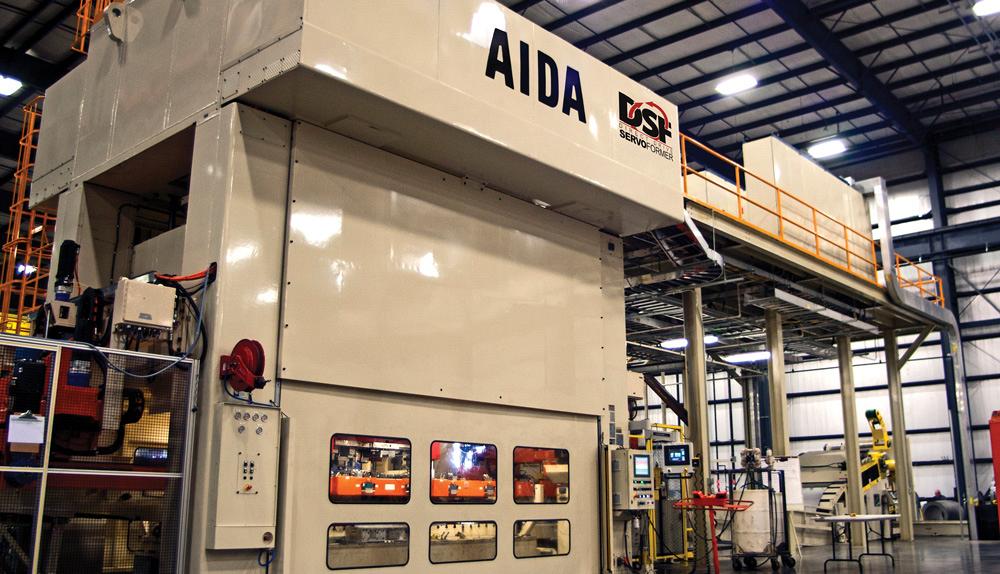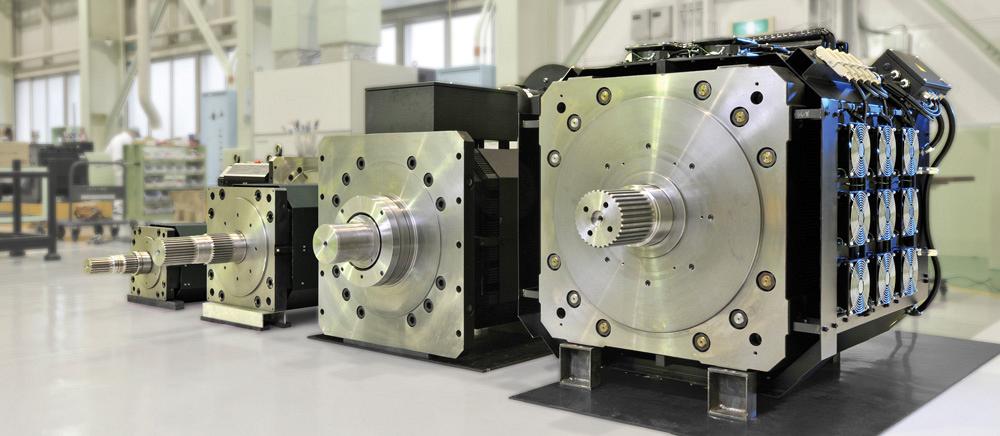Product Manager
- FMA
- The Fabricator
- FABTECH
- Canadian Metalworking
Categories
- Additive Manufacturing
- Aluminum Welding
- Arc Welding
- Assembly and Joining
- Automation and Robotics
- Bending and Forming
- Consumables
- Cutting and Weld Prep
- Electric Vehicles
- En Español
- Finishing
- Hydroforming
- Laser Cutting
- Laser Welding
- Machining
- Manufacturing Software
- Materials Handling
- Metals/Materials
- Oxyfuel Cutting
- Plasma Cutting
- Power Tools
- Punching and Other Holemaking
- Roll Forming
- Safety
- Sawing
- Shearing
- Shop Management
- Testing and Measuring
- Tube and Pipe Fabrication
- Tube and Pipe Production
- Waterjet Cutting
Industry Directory
Webcasts
Podcasts
FAB 40
Advertise
Subscribe
Account Login
Search
5 ways to get the most out of your servo press
Knowledge is power
- By Shrinivas Patil
- March 13, 2015
- Article
- Bending and Forming

A servo-driven press can be very powerful, but you can take full advantage of its capabilities only if you know how to use it.
Having the best tool is just half the answer. Knowledge is the other half. Technology is evolving constantly, enabling you to make products better and at a lower cost while consuming fewer resources.
To make the best use of servo technology, you must have the best practices and best people in place with ongoing training and support. You should assemble a cross-functional team of operators, die designers, engineers, and equipment providers who will work together to optimize the stamping line as a whole.
1. Know Your Application
The first step in getting more out of the servo press is understanding your current processes and their limitations—and how servo presses can help overcome limitations. Other things that you should consider are reverse tonnage, off-center loading, and die life. Applications with high reverse tonnage should be run in a silent blanking motion profile to reduce the reverse tonnage and increase the tool and press life. Small dies with concentrated load can be run in a single-point press; however, large dies with a high off-center load application should be run in a two- or four-point press to minimize the damaging effects that the imbalance creates.
It’s equally important to develop an understanding of the new materials that are being developed, such as high-strength steel and high-strength aluminum, to establish the specifications for the servo presses and the auxiliary equipment to meet future requirements.
In addition, being cognizant of the downstream processes that can be performed in a servo press can be beneficial as well. Secondary processes such as in-die tapping and assembly can be completed in a servo press with high productivity, thanks to its infinitely variable slide motion profile. Because servo technology allows the press to run at very low speeds, you can reduce punch velocities during the blanking stage of the stroke. This allows you to run dies with very low punch and die clearances to produce parts with nearly fine-blanking quality without sacrificing tool life, which would not be possible in a conventional mechanical press.
2. Know Your Servo Press Capacity, Capabilities
Understanding the tonnage, torque, and energy ratings of your servo press is critical. These specifications should meet or exceed current requirements as well as future needs (see lead photo). Those requirements will vary, depending on whether the application is blanking or deep drawing, progressive or transfer die. Servo presses give you the flexibility to run different motion profiles, such as eccentric, link, multiple restrike, and pendulum motion, in the same press.
High-torque, low-speed servomotors allow you to form parts at slower speeds with full energy for deep-draw applications. This is especially beneficial for forming advanced high-strength steels (AHSS) that require slow forming speeds but high energy (see Figure 1). The high-torque, low-speed servomotors also allow you to run the press at short strokes and high speeds for blanking applications simply by changing the slide motion profile.
Many times stamping manufacturers are forced to run dies in a mechanical press with higher tonnage than is required because the flywheel does not have sufficient energy required to make the part. In general, servo presses have a higher level of available energy compared to a mechanical press with equivalent tonnage, especially at lower speeds. This may allow you to form a part in a low-tonnage servo press.
3. Know Productivity Techniques
A servo press stroke does not have to be cyclical. Because a servo press can start and stop the slide at any point in the stroke, the stroke can be shortened to minimize the nonproductive portion of the stroke. Often the first thing you can do to increase productivity is to run the servo press in a pendulum motion, using the shortest stroke required for a particular part (see Figure 2).
Because a servo can run slower during forming, die designers can reduce the number of draw stations and, therefore, die cost. Slower speeds in the forming portion of the stroke can also reduce wall thinning, allowing you to reduce material thicknesses, and thus material cost, without defects. Slower forming speeds help minimize the scrap caused by material inconsistencies.

Figure 1
High-torque, low-speed servomotors allow you to run the press at short strokes and high speeds.
You can increase productivity further by integrating auxiliary equipment, such as smart die protection to minimize or even eliminate die crashes.
4. Know the Best Slide Profile
Understanding critical part quality parameters, tolerances, and pain points will help you zero in on the best slide profile for your application. A servo press’s infinitely programmable slide motion profile allows you to be able to do things that were not possible before, such as performing a restrike operation in the same die station and dwelling the slide at bottom dead center (BDC) (see Figure 3). You can minimize springback by using the multiple restrike motion profile. You can eliminate wall thinning and tool witness marks by reducing the punch impact velocity. You can prevent slug-pulling by dwelling the slide at BDC.
Often you can resolve part quality concerns through servo stroke-profile modifications much more quickly than laborious trial-and-error die modifications. Having the ability to dramatically slow down the press during the forming portion of the stroke helps you produce good parts even if you are stamping bad material.
5. Know Energy Reductions
Servo presses consume less energy for peak amperage compared to their equivalent mechanical presses. Most servo presses also regenerate energy during braking by storing the energy in capacitor banks, further reducing energy use.
Servo presses consume very little energy when the press is idle, such as during die changeover and production stops during part inspection.
Servo Training
A tool is valuable only if personnel know how to use it. It’s critical to train all of the personnel involved with the servo press to maximize its potential benefits. You will achieve the most benefits from servo presses by challenging die designers, engineers, and operators to “think outside of the box.” On-the-floor training and learning by interacting with other servo press users has become a vital part of taking full advantage of the servo press technology.
You may want to take advantage of opportunities press OEMs offer to test your current dies at their facilities. This way you can assess potential gains in part quality and productivity before purchasing a servo press. Press manufacturers may also offer tips on how servo press technology can be applied to improve your part quality, productivity, and tool life.
Initial discussions about servo press technology revolved around producing parts with the dies that were originally designed for mechanical presses. As dies are designed specifically for servo presses, you can realize significantly more benefits.
Optimization is not a one-time process; it is a continuous improvement process. You and your equipment providers should work together continually to improve part quality, increase productivity, and reduce the per-piece cost. With the development of newer AHSS and aluminum, stampers who use the latest technology and improve their processes will realize the most benefits from their servo presses and will be able to bring products to the market faster and at a lower cost.
About the Author
Shrinivas Patil
7660 Center Point 70 Blvd. 1971 Neil Ave.
Dayton, OH 45424
937-237-2382
Related Companies
subscribe now

The Fabricator is North America's leading magazine for the metal forming and fabricating industry. The magazine delivers the news, technical articles, and case histories that enable fabricators to do their jobs more efficiently. The Fabricator has served the industry since 1970.
start your free subscription- Stay connected from anywhere

Easily access valuable industry resources now with full access to the digital edition of The Fabricator.

Easily access valuable industry resources now with full access to the digital edition of The Welder.

Easily access valuable industry resources now with full access to the digital edition of The Tube and Pipe Journal.
- Podcasting
- Podcast:
- The Fabricator Podcast
- Published:
- 04/16/2024
- Running Time:
- 63:29
In this episode of The Fabricator Podcast, Caleb Chamberlain, co-founder and CEO of OSH Cut, discusses his company’s...
- Industry Events
16th Annual Safety Conference
- April 30 - May 1, 2024
- Elgin,
Pipe and Tube Conference
- May 21 - 22, 2024
- Omaha, NE
World-Class Roll Forming Workshop
- June 5 - 6, 2024
- Louisville, KY
Advanced Laser Application Workshop
- June 25 - 27, 2024
- Novi, MI
































